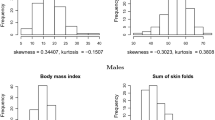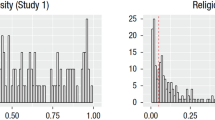Abstract
We consider exact procedures for testing the equality of means (location parameters) of two Laplace populations with equal scale parameters based on corresponding independent random samples. The test statistics are based on either the maximum likelihood estimators or the best linear unbiased estimators of the Laplace parameters. By conditioning on certain quantities we manage to express their exact distributions as mixtures of ratios of linear combinations of standard exponential random variables. This allows us to find their exact quantiles and tabulate them for several sample sizes. The powers of the tests are compared either numerically or by simulation. Exact confidence intervals for the difference of the means corresponding to those tests are also constructed. The exact procedures are illustrated via a real data example.
Similar content being viewed by others
References
Agosti E, Camerota G (1965) Some effects of hypnotic suggestion on respiratory function. Int J Clin Exp Hypn 13:149–156
Amari SV, Misra RB (1997) Closed-form expressions for distribution of sum of exponential random variables. IEEE Trans Reliab 46:519–522
Arnold BC, Balakrishnan N, Nagaraja HN (2008) A first course in order statistics, Classic edn. SIAM, Philadelphia
Govindarajulu Z (1966) Best linear unbiased estimates under symmetric censoring of the parameters of double exponential population. J Am Stat Assoc 61:248–258
Hald A (1998) A history of mathematical statistics from 1750 to 1930. Wiley, New York
Iliopoulos G, Balakrishnan N (2009) Conditional independence of blocked ordered data. Stat Probab Lett 79:1008–1015
Iliopoulos G, Balakrishnan N (2011) Exact likelihood inference for Laplace distribution based on type-II censored samples. J Stat Plan Inference 141:1224–1239
Iliopoulos G, MirMostafaee SMTK (2014) Exact prediction intervals for order statistics from the Laplace distribution based on the maximum likelihood estimators. Statistics 48:575–592
Jasiulewicz H, Kordecki W (2003) Convolutions of Erlang and of Pascal distributions with applications to reliability. Demonstr Math 36:231–238
Kotz S, Kozubowski TJ, Podgórski K (2001) The Laplace distribution and generalizations. Birkhäuser, Boston
Lehmann EL (1975) Nonparametrics. Statistical methods based on ranks. Holden- Day Inc., San Francisco
Nelson W (1982) Applied life data analysis. Wiley, New York
Robert CP, Casella G (2004) Monte Carlo statistical methods. Springer, New York
Zhu X, Balakrishnan N (2016) Exact inference for Laplace quantile, reliability, and cumulative hazard functions based on type-II censored data. IEEE Trans Reliab 65:164–178
Acknowledgements
The authors would like to thank the anonymous reviewer for his constructive comments which helped to improve the presentation.
Author information
Authors and Affiliations
Corresponding author
Appendix
Appendix
1.1 The set \({\varvec{P}}_{{\texttt {n}}_{\varvec{1}},{\texttt {n}}_{\varvec{2}}}\) and the weights \({\varvec{w(p)}}\)
Recall that the set \(P_{n_1,n_2}\) contains permutations \(p=(p_1,\ldots ,p_n)\) which represent the possible signs of X’s and Y’s in the expression
For any permutation of a vector consisting of 1’s, \((-\,1)\)’s and 0’s let \(k_1,k_2,\ell _1,\ell _2\) denote the positions of the first 1, the last \(-1\) and the first and last 0, respectively. If there is only one 0 set \(\ell _1=\ell _2=:\ell _0\).
-
(a)
Let \(n_1=2m_1,n_2=2m_2\) with \(m_1\leqslant m_2\) and \(m=m_1+m_2\). In this case, \(P_{n_1,n_2}\) contains the permutations of \((1_m,-1_m)\) for which \(k_1>m_1\), \(k_2\leqslant n-m_1\), and the inequalities \(k_1\leqslant m_2\) and \(k_2>n-m_2\) do not hold simultaneously. To see why, observe first that in this case all X’s and Y’s are present in the right hand side (rhs) of (14) and thus there is no 0 in the signs of \(Z_{1:n},\ldots ,Z_{n:n}\). Clearly, if \(p\in P_{n_1,n_2}\) then we must have \(m_1<k_1\) and \(k_2\leqslant n-m_1\) since the first \(m_1\) and last \(m_1\) entries of p must all be \(-1\) and 1, respectively. This leaves the \(n_2\) middle positions to be filled with \(m_2\) 1’s and \(m_2\) \((-\,1)\)’s and this can be done with \(\left( {\begin{array}{c}n_2\\ m_2\end{array}}\right) \) different ways. On the other hand we cannot have at the same time \(k_1\leqslant m_2\) and \(k_2>n-m_2\) because if \(k_1\leqslant m_2\) then the \(k_1-1\) \((-\,1)\)’s preceding the first 1, necessarily include the \(m_1\) \((-\,1)\)’s of X’s which means that the last \(-1\) comes from the Y’s and thus it must precede their \(m_2\) 1’s. Since the number of permutations having the first 1 at position \(k_1\) and the last \(-1\) at position \(k_2\) are \(\left( {\begin{array}{c}k_2-k_1-1\\ m_2-k_1\end{array}}\right) \), we conclude that the number of elements of \(P_{n_1,n_2}\) is
$$\begin{aligned} \left( {\begin{array}{c}n_2\\ m_2\end{array}}\right) -\sum _{k_1=m_1+1}^{m_2}\sum _{k_2=n-m_2+1}^{n-m_1}\left( {\begin{array}{c}k_2-k_1-1\\ m-k_1\end{array}}\right) = \left( {\begin{array}{c}n_2\\ m_2\end{array}}\right) -\sum _{i=1}^{m_2-m_1}\sum _{j=1}^{m_2-m_1}\left( {\begin{array}{c}n_2-i-j\\ m_2-i\end{array}}\right) . \end{aligned}$$The number of different joint orderings of X’s and Y’s which result to the permutation p is
$$\begin{aligned} w(p) = \left\{ \begin{array}{l@{\quad }l}\left( {\begin{array}{c}m\\ m_1\end{array}}\right) ^2,&{}\hbox {if }k_1=m+1 \hbox { (and thus } k_2=m)\\ \left( {\begin{array}{c}k_1-1\\ m_1\end{array}}\right) \left( {\begin{array}{c}n-k_2\\ m_2\end{array}}\right) +\left( {\begin{array}{c}k_1-1\\ m_2\end{array}}\right) \left( {\begin{array}{c}n-k_2\\ m_1\end{array}}\right) ,&\hbox {if } k_1\leqslant m\hbox { (and thus }k_2>m).\end{array}\right. \end{aligned}$$To see why, observe first that \(k_1=m+1\) implies \(k_2=m\) and vice versa and this corresponds only to the permutation \((-\,1_m,1_m)\). Since there are \(m_1\) 1’s (resp., \((-\,1)\)’s) corresponding to X’s and \(m_2\) 1’s (resp., \((-\,1)\)’s) corresponding to Y’s we have \(\left( {\begin{array}{c}m\\ m_1\end{array}}\right) \) possible joint orderings giving the vector \(-1_m\) (resp., \(1_m\)). When \(k_1\leqslant m\) we have \(k_2>m\) and there are two possibilities: The \(k_1-1\) \((-\,1)\)’s preceding the first 1 include either all \(m_1\) \((-\,1)\)’s corresponding to X’s or all \(m_2\) \((-\,1)\)’s corresponding to Y’s. The first case implies that the \(n-k_2\) 1’s succeeding the last \(-1\) include all \(m_2\) 1’s corresponding to Y’s while the second implies that include all \(m_1\) 1’s corresponding to X’s.
-
(b)
Let \(n_1=2m_1-1,n_2=2m_2-1\) with \(m_1\leqslant m_2\) and \(m=m_1+m_2-1\). In this case \(P_{n_1,n_2}\) contains the permutations of \((1_{m-1},-1_{m-1},0_2)\) having \(m_1\leqslant \ell _1\leqslant m\), \(m<\ell _2\leqslant n-m_1+1\) while \(\ell _1\leqslant m_2\), \(\ell _2\leqslant n-m_2+1\) do not hold simultaneously. To see why, observe that in this case the medians of X’s and Y’s do not appear in the rhs of (14) and thus there are two 0’s among the signs of \(Z_{1:n},\ldots ,Z_{n:n}\), one corresponding to the X’s and one corresponding to the Y’s. Clearly, the zero corresponding to the X’s must have on its left at least \(m_1-1\) negative ones and on its right at least \(m_1-1\) ones and the zero corresponding to Y’s must have on its left at least \(m_2-1\) negative ones and on its right at least \(m_2-1\) ones. This implies that the first zero lies among the first m positions and the second zero lies among the last m positions. Hence, \(\ell _1\geqslant m_1\) and \(\ell _2\leqslant n-m_2+1\) (since \(m_1\leqslant m_2\)) and \(\ell _1\leqslant m<\ell _2\). Moreover, all signs preceding the first zero are \(-1\) while all signs succeeding the second zero are 1. Thus, the number of feasible permutations having zeros at positions \(\ell _1,\ell _2\) are \(\left( {\begin{array}{c}\ell _2-\ell _1-1\\ m-\ell _1\end{array}}\right) \) which means that there are \(\sum _{\ell _1=m_1}^m\sum _{\ell _2=m+1}^{n-m_1+1}\left( {\begin{array}{c}\ell _2-\ell _1-1\\ m-\ell _1\end{array}}\right) \) permutations satisfying the above requirements. However, if the first zero lies from position \(m_1\) till \(m_2\) it necessarily corresponds to the X’s and thus the second zero must have on its right at least \(m_2-1\) ones. This implies that \(\ell _1\leqslant m_2\) and \(\ell _2\leqslant n-m_2+1\) cannot hold simultaneously. This restriction excludes \(\sum _{\ell _1=m_1}^{m_2-1}\sum _{\ell _2=n-m_2+2}^{n-m_1+1}\left( {\begin{array}{c}\ell _2-\ell _1-1\\ m-\ell _1\end{array}}\right) \) permutations. Summarizing, the number of permutations in \(P_{n_1,n_2}\) equals
$$\begin{aligned}&\sum _{\ell _1=m_1}^m\sum _{\ell _2=m+1}^{n-m_1+1}\left( {\begin{array}{c}\ell _2-\ell _1-1\\ m-\ell _1\end{array}}\right) -\sum _{\ell _1=m_1}^{m_2-1}\sum _{\ell _2=n-m_2+1}^{n-m_1+2}\left( {\begin{array}{c}\ell _2-\ell _1-1\\ m-\ell _1\end{array}}\right) \\&\quad = \sum _{i=1}^{m_2}\sum _{j=1}^{m_2}\left( {\begin{array}{c}n_2+1-i-j\\ m_2-i\end{array}}\right) -\sum _{i=1}^{m_2-m_1}\sum _{j=1}^{m_2-m_1}\left( {\begin{array}{c}n_2+1-i-j\\ m_2-i\end{array}}\right) . \end{aligned}$$Working similarly to the even sample sizes case it can be shown that the number of different joint orderings of X’s and Y’s resulting to the permutation p is
$$\begin{aligned} w(p) = \left\{ \begin{array}{l@{\quad }l}\left( {\begin{array}{c}m-1\\ m_1-1\end{array}}\right) ^2,&{}\hbox {if } \ell _1=m\hbox { and } \ell _2=m+1\\ \left( {\begin{array}{c}\ell _1-1\\ m_1-1\end{array}}\right) \left( {\begin{array}{c}n-\ell _2\\ m_2-1\end{array}}\right) +\left( {\begin{array}{c}\ell _1-1\\ m_2-1\end{array}}\right) \left( {\begin{array}{c}n-\ell _2\\ m_1-1\end{array}}\right) ,&\hbox {otherwise}.\end{array}\right. \end{aligned}$$ -
(c)
Let \(n_1=2m_1,n_2=2m_2-1\) and \(m=m_1+m_2-1\). In this case \(P_{n_1,n_2}\) contains the permutations of \((1_m,-1_m,0)\) which fall into one of the following three cases: (i) \(\ell _0=m+1\), \(k_1=m+2\), \(k_2=m\); (ii) \(m_2\leqslant \ell _0<m+1\), \(\ell _0<k_1\leqslant m+2\), \(m\leqslant k_2\leqslant n-m_1\); (iii) \(m+1<\ell _0\leqslant n-m_2+1\), \(m_1<k_1\leqslant m+2\), \(m\leqslant k_2<\ell _0\). To see why, observe that in this case the median of Y’s does not appear in the rhs of (14) while all X’s are present and thus there is exactly one 0 among the signs of \(Z_{1:n},\ldots ,Z_{n:n}\) which corresponds to the Y’s. Clearly, the zero must have on its left at least \(m_2-1\) negative ones and on its right at least \(m_2-1\) ones and this implies that \(m_2\leqslant \ell _0\leqslant n-m_2+1\). Regarding the first 1, if it corresponds to the X’s it must have on its left at least \(m_1\) \((-\,1)\)’s while if it corresponds to the Y’s it must have on its left at least \(m_2-1\) \((-\,1)\)’s and the zero which means that \(k_1>\min \{m_1,m_2\}\). On the other hand, since there are exactly \(m_1+m_2-1=m\) ones, the largest possible position for the first 1 is position \(n-m+1=m+2\). By symmetry the last negative one can appear between position m and \(n-\min \{m_1,m_2\}\). Now, case (i) is easy to understand: When \(\ell _0=m+1\), i.e., the zero is at the central position of the permutation vector, it must have all negative ones on its left and all ones on its right. For case (ii) where \(\ell _0<m+1\), the zero cannot have on its left any ones while the last negative one corresponds necessarily to the X’s, thus \(k_1>\ell _0\) and \(k_2\leqslant n-m_1\). Once again the argument for case (iii) follows by symmetry. In order to count the permutations corresponding to case (ii), note that since before the zero are only negative ones and the last \(m_1\) positions have only ones there are \(n-\ell _0-m_1=n_2+m_1-\ell _0\) positions left to be filled with the rest \(m_2-1\) ones. This can happen in \(\left( {\begin{array}{c}n_2+m_1-\ell _0\\ m_2-1\end{array}}\right) \) ways which means that the number of \(p\in P_{n_1,n_2}\) having \(\ell _0<m+1\) are
$$\begin{aligned} \sum _{\ell _0=m_2}^m\left( {\begin{array}{c}n_2+m_1-\ell _0\\ m_2-1\end{array}}\right) = \sum _{i=m_2-m_1}^{m_2-1}\left( {\begin{array}{c}n_2-i\\ m_2-1\end{array}}\right) . \end{aligned}$$By symmetry, this is also the number of p’s corresponding to case (iii). By taking into account the unique p having \(\ell _0=m\) we conclude that the number of p’s in \(P_{n_1,n_2}\) is
$$\begin{aligned} 1+2\sum _{i=m_2-m_1}^{m_2-1}\left( {\begin{array}{c}n_2-i\\ m_2-1\end{array}}\right) . \end{aligned}$$Working as in the previous cases we can show that the number of joint orderings resulting to the permutation p is
$$\begin{aligned} w(p) = \left\{ \begin{array}{l@{\quad }l} \left( {\begin{array}{c}m_1+m_2-1\\ m_2-1\end{array}}\right) ^2,&{}\hbox {if } \ell _0=m,\\ \left( {\begin{array}{c}\ell _0-1\\ m_2-1\end{array}}\right) \left( {\begin{array}{c}n-k_2\\ m_1\end{array}}\right) ,&{}\hbox {if } \ell _0<m,\\ \left( {\begin{array}{c}k_1-1\\ m_1\end{array}}\right) \left( {\begin{array}{c}n-\ell _0\\ m_2-1\end{array}}\right) ,&\hbox {if } \ell _0>m. \end{array}\right. \end{aligned}$$
Rights and permissions
About this article
Cite this article
Tafiadi, M., Iliopoulos, G. Exact inference for the difference of Laplace location parameters. Metrika 80, 829–861 (2017). https://doi.org/10.1007/s00184-017-0630-3
Received:
Published:
Issue Date:
DOI: https://doi.org/10.1007/s00184-017-0630-3




